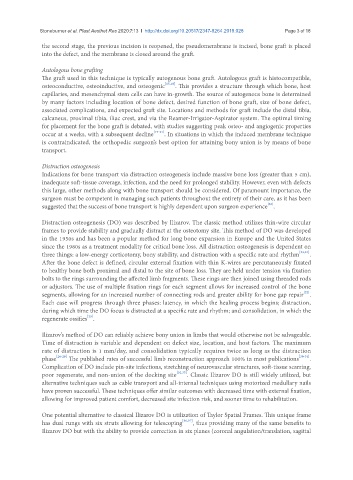Page 178 - Read Online
P. 178
Stoneburner et al. Plast Aesthet Res 2020;7:13 I http://dx.doi.org/10.20517/2347-9264.2019.028 Page 3 of 18
the second stage, the previous incision is reopened, the pseudomembrane is incised, bone graft is placed
into the defect, and the membrane is closed around the graft.
Autologous bone grafting
The graft used in this technique is typically autogenous bone graft. Autologous graft is histocompatible,
osteoconductive, osteoinductive, and osteogenic [17,18] . This provides a structure through which bone, host
capillaries, and mesenchymal stem cells can have in-growth. The source of autogenous bone is determined
by many factors including location of bone defect, desired function of bone graft, size of bone defect,
associated complications, and expected graft site. Locations and methods for graft include the distal tibia,
calcaneus, proximal tibia, iliac crest, and via the Reamer-Irrigator-Aspirator system. The optimal timing
for placement for the bone graft is debated, with studies suggesting peak osteo- and angiogenic properties
occur at 4 weeks, with a subsequent decline [19-21] . In situations in which the induced membrane technique
is contraindicated, the orthopedic surgeon’s best option for attaining bony union is by means of bone
transport.
Distraction osteogenesis
Indications for bone transport via distraction osteogenesis include massive bone loss (greater than 5 cm),
inadequate soft-tissue coverage, infection, and the need for prolonged stability. However, even with defects
this large, other methods along with bone transport should be considered. Of paramount importance, the
surgeon must be competent in managing such patients throughout the entirety of their care, as it has been
[22]
suggested that the success of bone transport is highly dependent upon surgeon experience .
Distraction osteogenesis (DO) was described by Ilizarov. The classic method utilizes thin-wire circular
frames to provide stability and gradually distract at the osteotomy site. This method of DO was developed
in the 1950s and has been a popular method for long bone expansion in Europe and the United States
since the 1980s as a treatment modality for critical bone loss. All distraction osteogenesis is dependent on
three things: a low-energy corticotomy, bony stability, and distraction with a specific rate and rhythm [23,24] .
After the bone defect is defined, circular external fixation with thin K-wires are percutaneously fixated
to healthy bone both proximal and distal to the site of bone loss. They are held under tension via fixation
bolts to the rings surrounding the affected limb fragments. These rings are then joined using threaded rods
or adjustors. The use of multiple fixation rings for each segment allows for increased control of the bone
[22]
segments, allowing for an increased number of connecting rods and greater ability for bone gap repair .
Each case will progress through three phases: latency, in which the healing process begins; distraction,
during which time the DO focus is distracted at a specific rate and rhythm; and consolidation, in which the
[25]
regenerate ossifies .
Ilizarov’s method of DO can reliably achieve bony union in limbs that would otherwise not be salvageable.
Time of distraction is variable and dependent on defect size, location, and host factors. The maximum
rate of distraction is 1 mm/day, and consolidation typically requires twice as long as the distraction
phase [26-29] The published rates of successful limb reconstruction approach 100% in most publications [30-34] .
Complication of DO include pin-site infections, stretching of neurovascular structures, soft-tissue scarring,
poor regenerate, and non-union of the docking site [30,35] . Classic Ilizarov DO is still widely utilized, but
alternative techniques such as cable transport and all-internal techniques using motorized medullary nails
have proven successful. These techniques offer similar outcomes with decreased time with external fixation,
allowing for improved patient comfort, decreased site infection risk, and sooner time to rehabilitation.
One potential alternative to classical Ilizarov DO is utilization of Taylor Spatial Frames. This unique frame
has dual rungs with six struts allowing for telescoping [36,37] , thus providing many of the same benefits to
Ilizarov DO but with the ability to provide correction in six planes (coronal angulation/translation, sagittal

